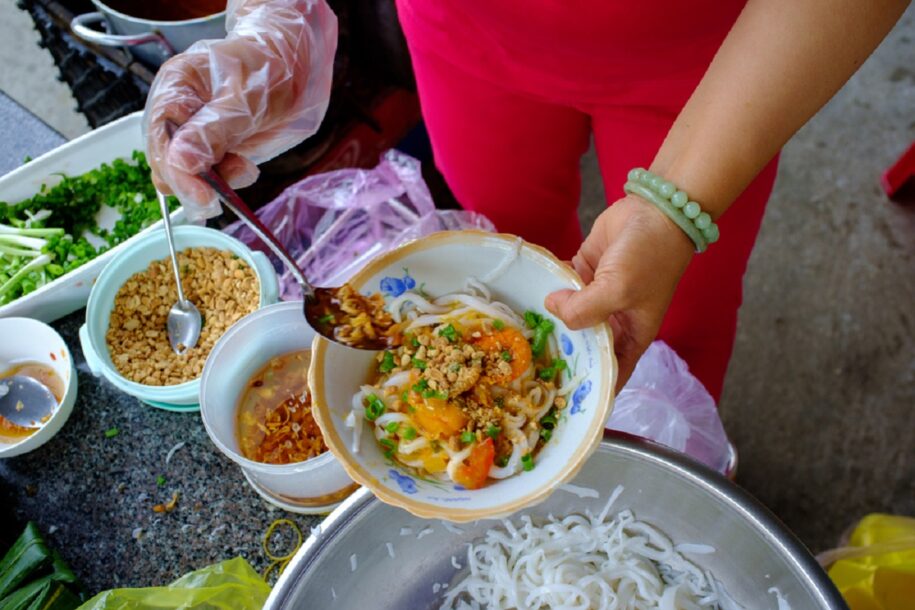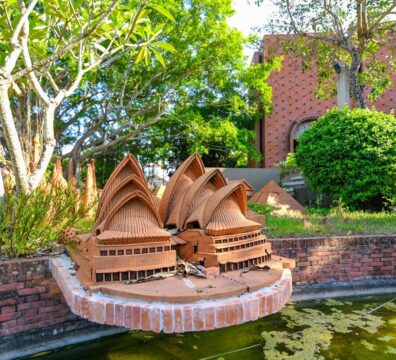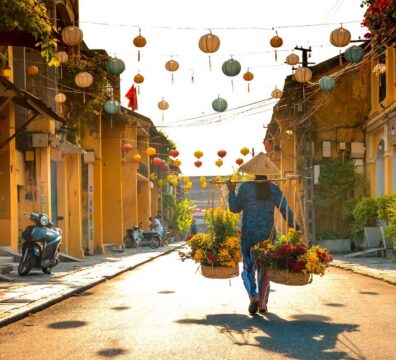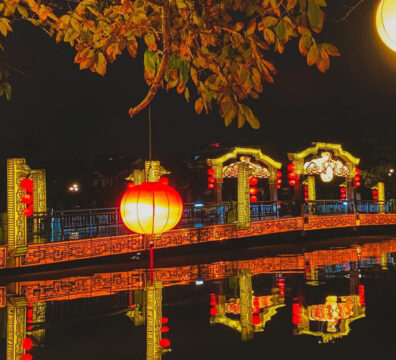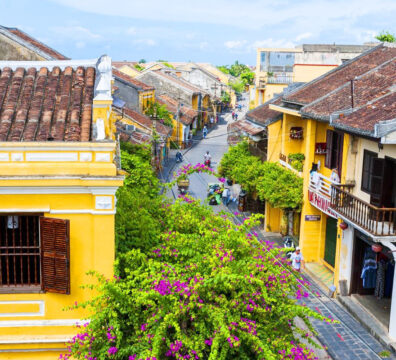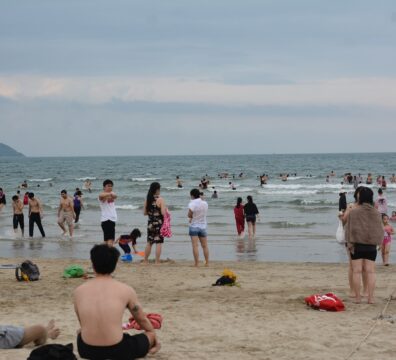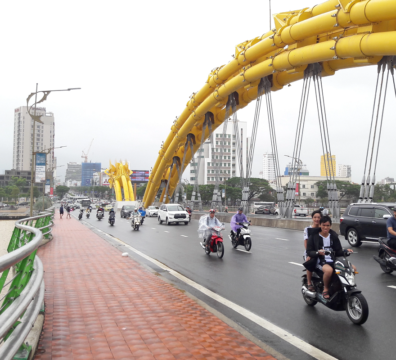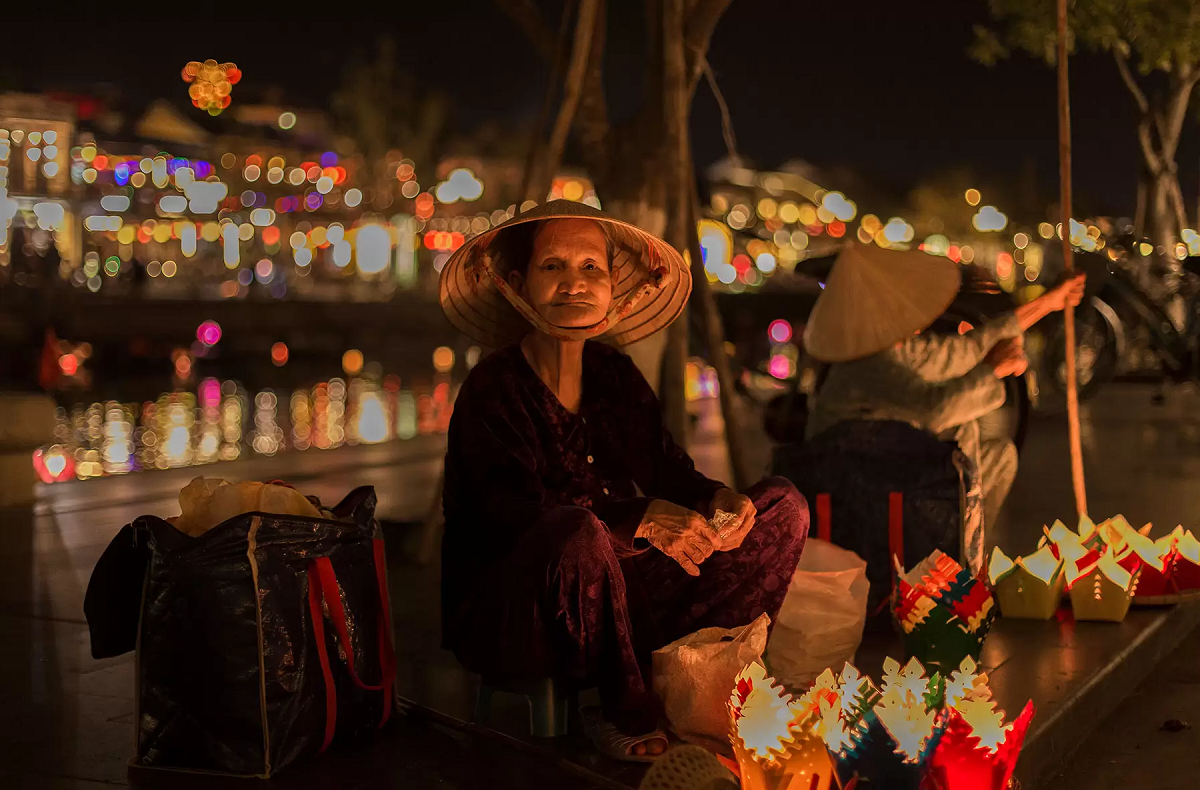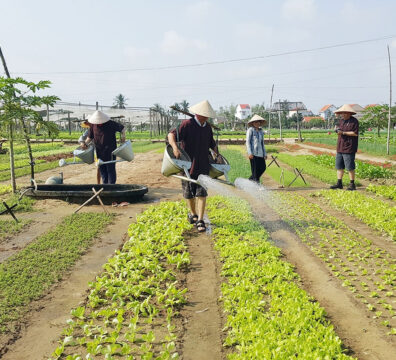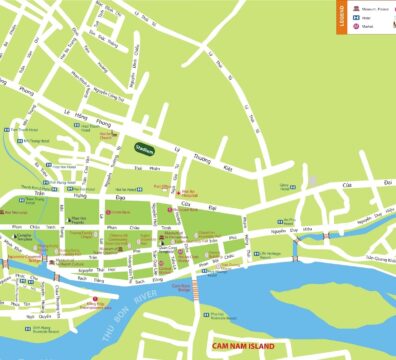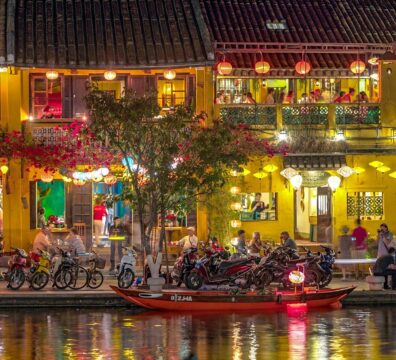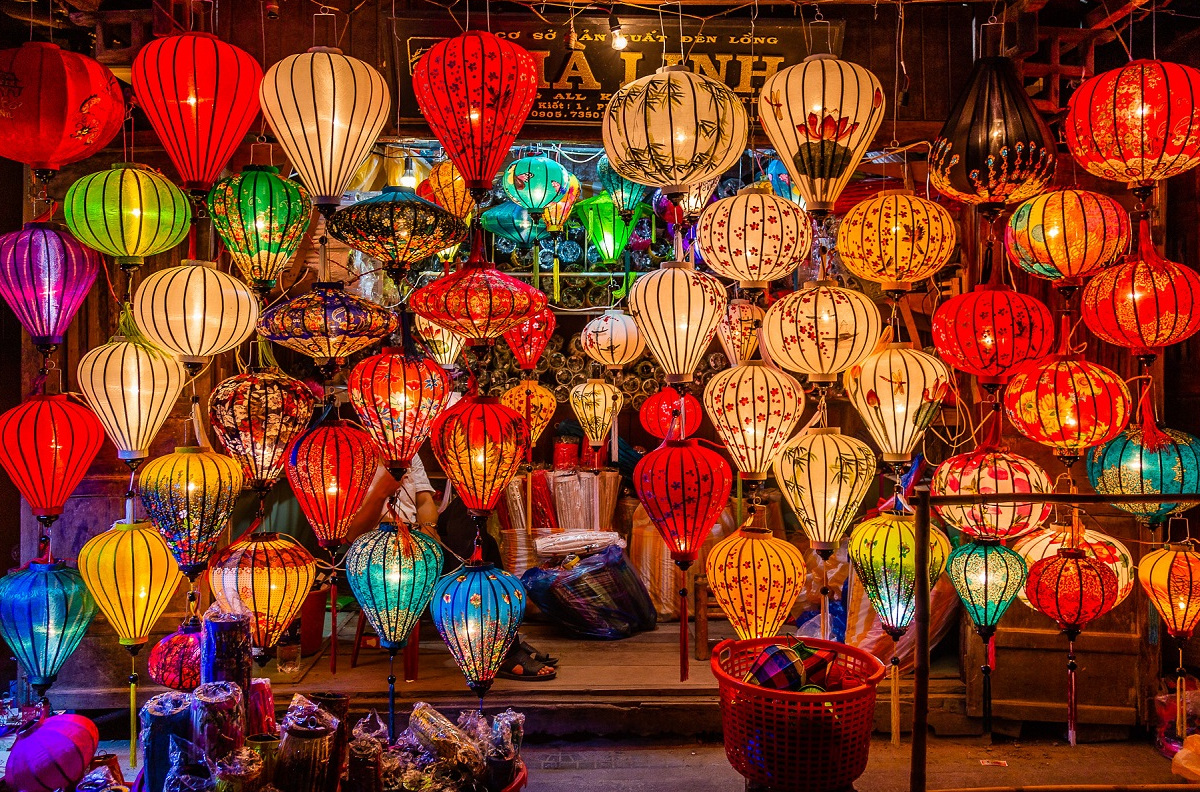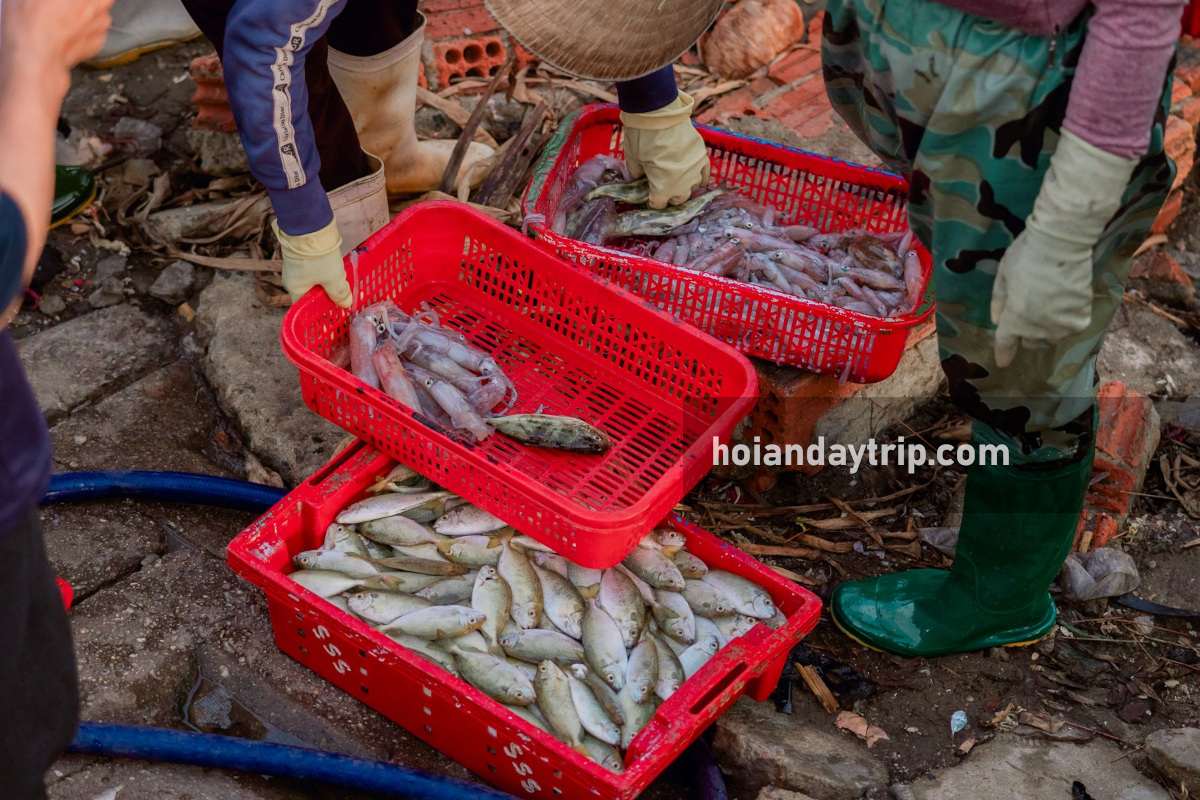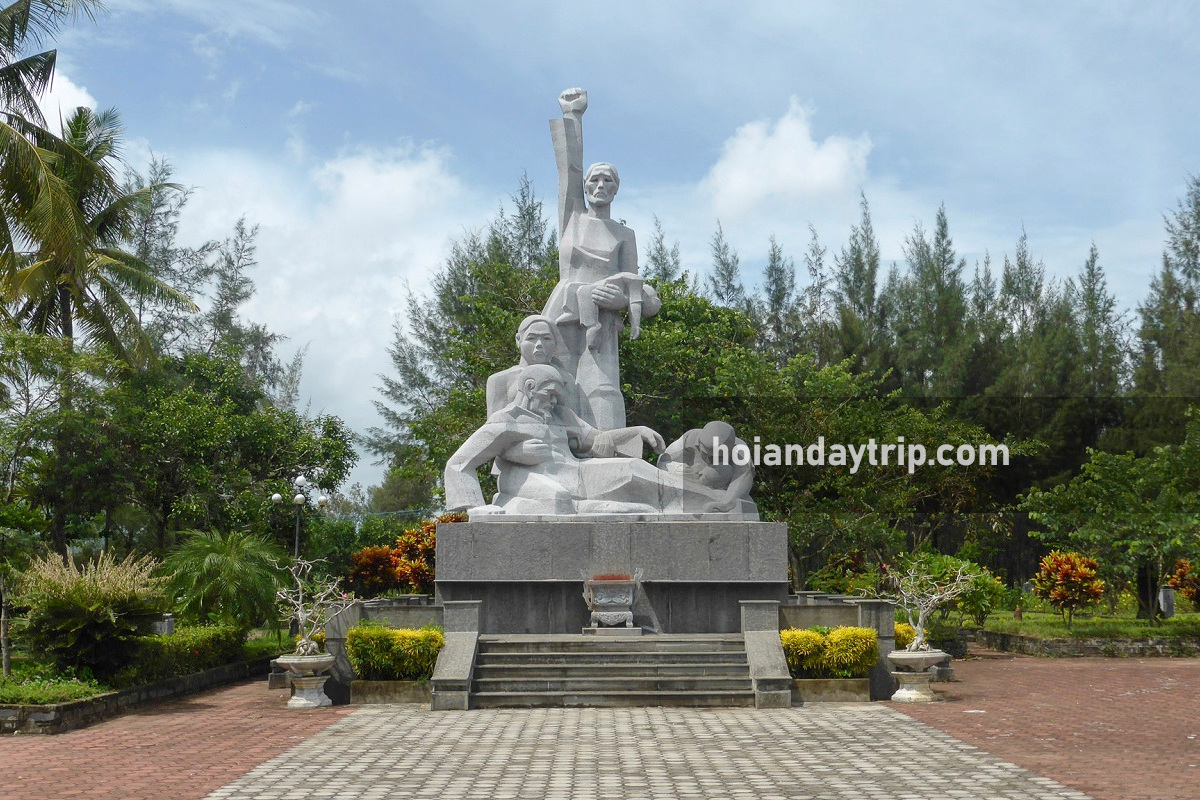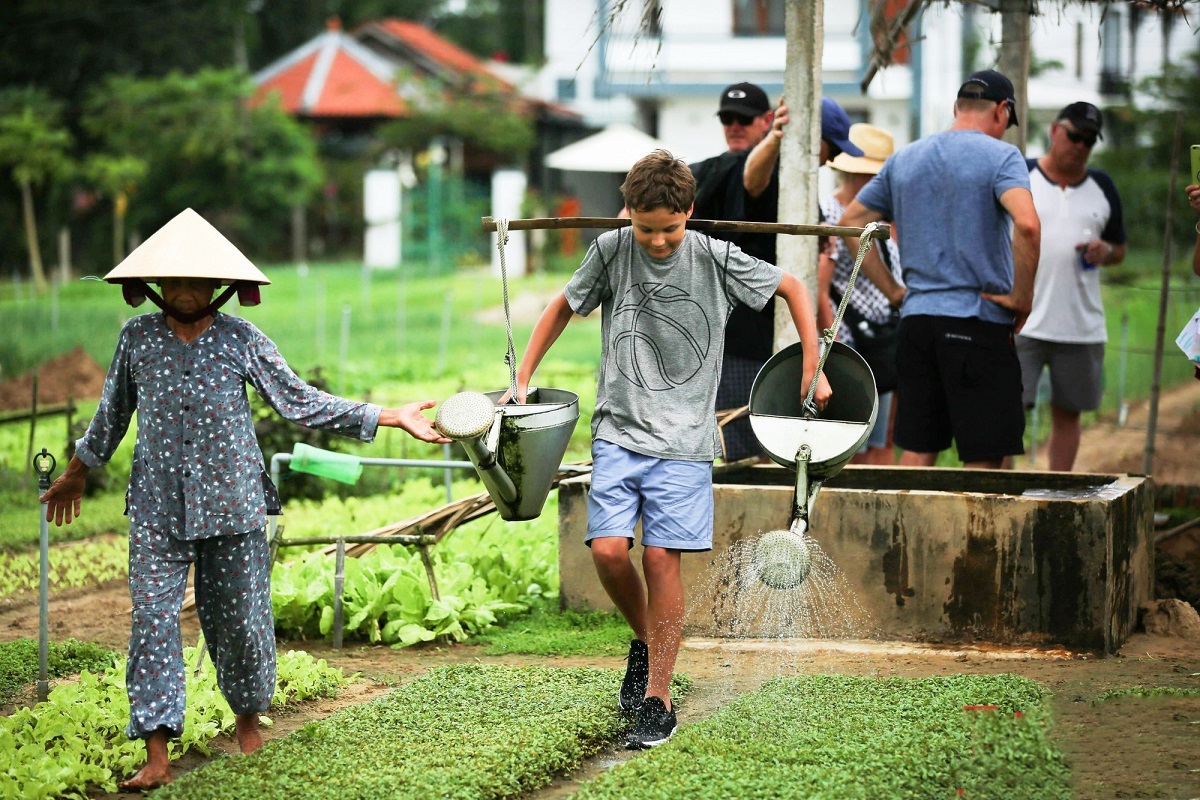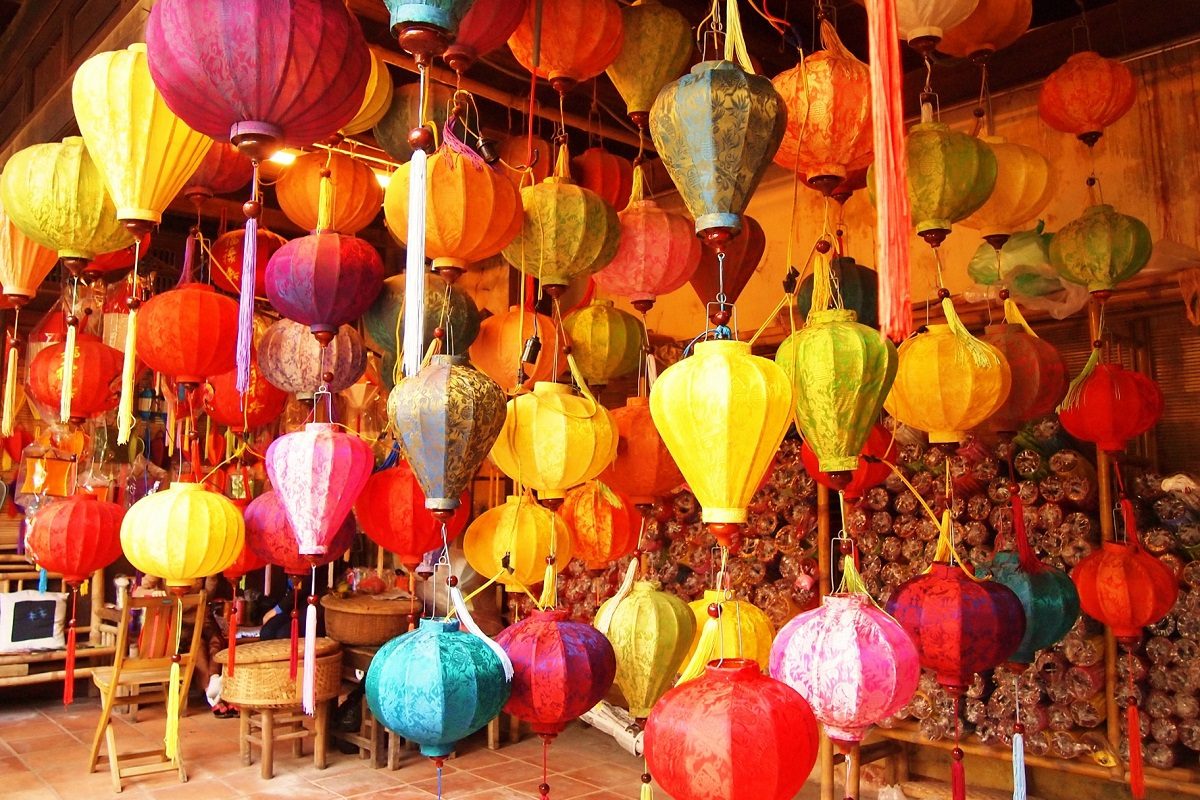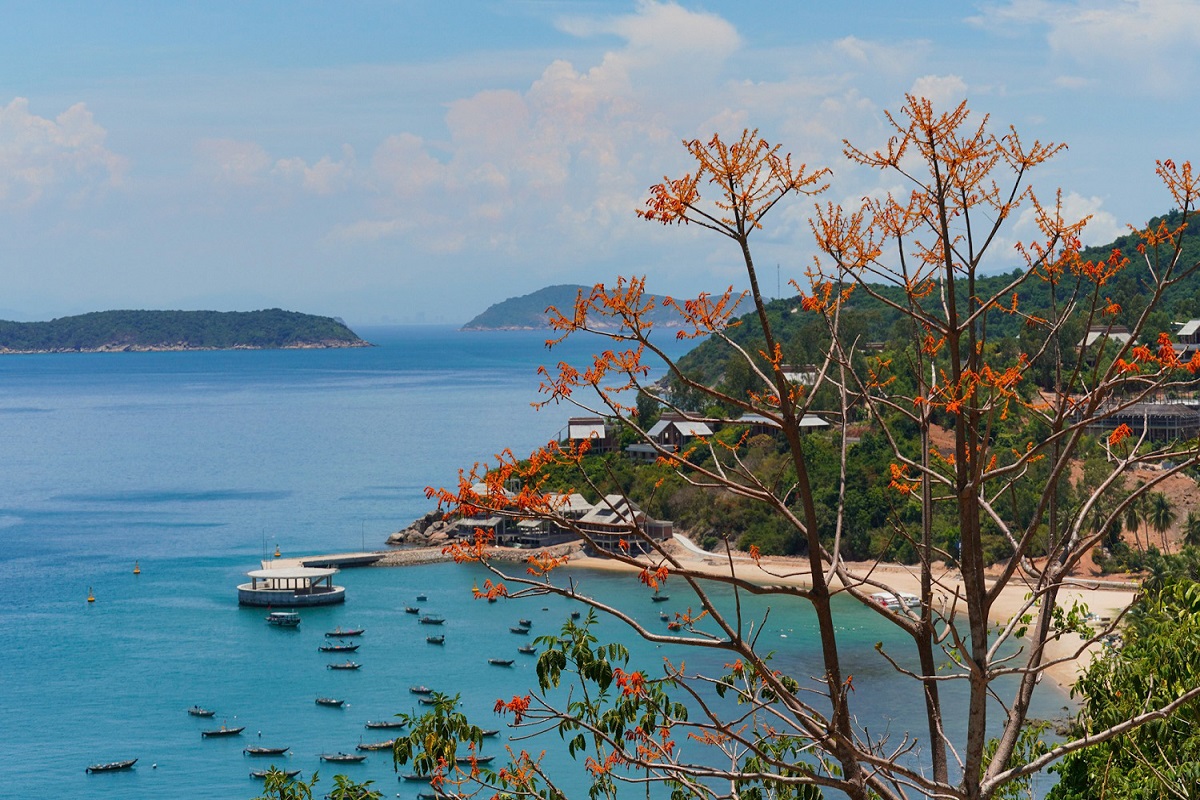Hoi An is a melting pot where people from different parts of Vietnam and countries in the world have gathered and exchanged their cultures. As a result, this town has a rich cuisine in which travelers will find many distinctions. The largest influences come from Japanese and Chinese who have resided since the 15th century and the Chams whose food culture was partially influenced by Indian. The latest one is from the French who colonized the country in 19th and 20th centuries. Banh mi – a world-famous bread from Vietnam was first made at the same time. This guide proudly introduces Hoi An’s food specialties, one of the most particular things about the world heritage town. If would like to know the secrets behind each, should book a guided food tour to stop, eat and listen to interesting information.
Read also:
- The Best Places to Eat in Hoi An
- Hoi An Food Tour
- Things to Do in Hoi An
- Best Things to Do in Hoi An

Table of content
- 1 Cao Lầu
- 2 Mì Quảng
- 3 Bánh Mì
- 4 Bánh Bao Bánh Vạc
- 5 Cơm Gà
- 6 Phở Hội An
- 7 Bánh Uớt Cuốn Thịt Nướng
- 8 Hoành Thánh Chiên
- 9 Bánh Xèo
- 10 Bánh Bèo
- 11 Bánh Đập
- 12 Hến Xào
- 13 Bánh Ít
- 14 Related Posts
- 15 Bach Ma National Park: Hiking, Trekking in Da Nang and Hoi An
- 16 Hoi An Wet Season: What to Do in Hoi An When It Rains?
- 17 Thanh Ha Terracotta Park
- 18 Vinwonders Nam Hoi An Theme Park (formerly Vinpearl Nam Hoi An)
- 19 Am Phu Cave (Hell Cave) – Things to Do in Da Nang
- 20 Hoi An or Hue: Which is Better?
- 21 The Official Hoi An Travel Guide (MUST READ)
- 22 The Hoi An Market (Hoi An Central Market) Complete Guide
- 23 Hoi An Memories Show: The Best of Hoi An Impression Theme Park
- 24 Hoi An Bridge: Famous Bridges in Hoi An
- 25 How to Get From Hoi An to My Son Sanctuary
- 26 Hoi An’s Chinese Assembly Halls and Chinese Temples
- 27 Hoi An Walking Tours: Heritage, Foods, Photography & Locals
- 28 Hoi An Self Guided Walking Tour – Hoi An On Your Own
- 29 How to Visit Golden Bridge Vietnam
- 30 Unique Experiences in Hoi An and Why?
- 31 An Bang Beach: A Guide to Hoi An’s Best Beach
- 32 Experiences in Hoi An: Get Insight Into Hoi An’s Local Culture
- 33 Things to Do in Ba Na Hills Besides Golden Bridge
- 34 Hoi An Nightlife: What to Do in Hoi An At Night?
- 35 Hoi An Countryside: Villages, Rice Fields & Tours
- 36 How to Get to Golden Bridge From Hoi An
- 37 Hoi An Entrance Fee: Old Town, Golden Bridge, My Son, More
- 38 Hoi An Airport: Everything You Need to Know
- 39 Hoi An Lantern Boat Ride on Hoai River
- 40 Hoi An Private Car and Driver
- 41 What to Do in Hoi An Ancient Town
- 42 Da Nang and Hoi An Itinerary for Visitors Staying Overnight in Hoi An
- 43 Hoi An 3 Day Itinerary: A Travel Plan for 3 Days in Hoi An
- 44 Hoi An Free Things to Do: Budget Travel in Hoi An Vietnam
- 45 Hoi An One Day Itinerary: A Travel Plan for One Day in Hoi An
- 46 Hoi An Half-Day Tours: Guide to Half Day Trips From Hoi An
- 47 Hoi An Day Tours: A Guide to Best Day Trips From Hoi An
- 48 Hoi An Beach: A Guide to All Beaches in Hoi An Vietnam
- 49 Hoi An Food Specialties
- 50 How to Get From Hoi An to Da Nang
- 51 Hoi An Cheap Things to Do: All Solo Travelers Need to Know
- 52 Hoi An Best Things To Do: Recommendations from Local Experts
- 53 Hoi An Things to Do: All What Can You Do in Hoi An Vietnam
- 54 Hoi An Things Not to Miss: A Guide to Must Do in Hoi An
- 55 Hoi An or Da Nang: Which is Better for First Time Visitor?
- 56 Hoi An Pottery Village: A Guide to Thanh Ha Pottery Village
- 57 Hoi An Ancient Town Tour
- 58 Hoi An Old Town Ticket: Price, Sellers, Included Sites, More
- 59 My Son Sanctuary Tour
- 60 Hoi An Lanterns: Festival, Making Class, Where to Buy, More
- 61 Hoi An Best Area to Stay: Guide to Where to Stay in Hoi An
- 62 Hoi An Weather by Month: Guide to Hoi An Monthly Weather
- 63 Hoi An River Cruise: Guide to The Best Boat Tour in Hoi An
- 64 Hoi An Old Town Boats: Guide to Boat Rides in Hoi An Town
- 65 Hoi An 2 Day Itinerary: Traveler Guide to 2 Days in Hoi An
- 66 Cham Island Hoi An
- 67 Hoi An Basket Boat Ride
- 68 Hoi An Coconut Village: A Guide to Cam Thanh Coconut Village
- 69 Hoi An Cham Temples: My Son Sanctuary & Quang Nam Temples
- 70 How to Get from Da Nang Airport to Hoi An
- 71 Da Nang to Hoi An: Best Da Nang Airport Transfer and More
- 72 Hoi An Tour Guide: How to Find a Private Tour Guide in Hoi An
- 73 Hoi An Ancient Town Attractions
- 74 Hoi An Old Town Map
- 75 Tra Que Vegetable Village
- 76 Guide to Hoi An Lantern Festival – Hoi An Full Moon Festival
- 77 Hoi An Night Market: A Thing to Do in Hoi An at Night
- 78 My Son Sanctuary Travel Guide
- 79 Hoi An Old Town Unesco World Heritage – Hoi An Travel Guide
- 80 Featured Tours and Experiences
- 80.0.1 Bach Ma National Park Tour from Hue
- 80.0.2 Bach Ma National Park Tour from Da Nang/Hoi An
- 80.0.3 Hoi An Sunrise Fish Market Tour
- 80.0.4 My Lai Massacre Tour
- 80.0.5 Golden Bridge/Ba Na Hills & Hoi An Tour
- 80.0.6 Hoi An Instagram Tour
- 80.0.7 Ky Anh Tunnel & Tam Thanh Mural Village Tour
- 80.0.8 Da Nang to Hue Motorbike Tour with Hai Van Pass & Easy Rider (1 Way)
- 80.0.9 Hue to Da Nang Motorbike Tour with Hai Van Pass & Easy Ride (1 Way)
- 80.0.10 Hue to Hoi An Motorbike Tour with Hai Van Pass & Easy Rider (1 Way)
- 80.0.11 Hoi An to Hue Motorbike Tour with Hai Van Pass & Easy Rider (1 Way)
- 80.0.12 Tra Que Vegetable Village Tour with Cooking Class
- 80.0.13 Ba Na Hills Half Day Tour from Hoi An
- 80.0.14 Marble Mountain & Hoi An Day Tour from Da Nang Port
- 80.0.15 Hue Day Tour from Chan May Port with Lunch
- 80.0.16 Marble Mountain & Hoi An Tour from Chan May Port
- 80.0.17 Ba Na Hills/Golden Bridge Tour from Da Nang Port
- 80.0.18 Ba Na Hills/Golden Bridge Tour from Chan May Port
- 80.0.19 Golden Bridge Private Tour with Ba Na Hills & Lunch
- 80.0.20 Ba Na Hills Afternoon Tour with Golden Hands Bridge
- 80.0.21 Ba Na Hills Private Tour with Golden Hands Bridge
- 80.0.22 Ba Na Hills Half Day Tour with Golden Bridge
- 80.0.23 Ba Na Hills Early Morning Tour to Beat the Crowds
- 80.0.24 Golden Bridge and Ba Na Hills Night Tour
- 80.0.25 Golden Hands Bridge Tour In Sunrise or Sunset (1/2 Day)
- 80.0.26 Cam Kim Island Bicycle Tour From Hoi An
- 80.0.27 Cham Island Tour From Hoi An (Group Tour)
- 80.0.28 Cham Island Tour From Da Nang (Group Tour)
- 80.0.29 Hoi An Vegetarian Food Tour
- 80.0.30 Hoi An Evening Walking Food Tour with Local Foodie
- 80.0.31 Private Hoi An Basket Boat Tour (Shuttle Bus, Bicycle, Bike)
- 80.0.32 Half-day Am Phu Cave Tour (Private)
- 80.0.33 Hoi An Countryside Tour by Electric Car or Bike
- 80.0.34 Da Nang Tour Package From Singapore
- 80.0.35 Hoi An Evening Tour From Da Nang with Lantern Boat Ride
- 80.0.36 Hoi An Walking Food Tour Through Laneways
- 80.0.37 My Son Sanctuary and Hoi An Old Town Tour
- 80.0.38 My Son Day Trip From Hoi An including Marble Mountains and Basket Boat
- 80.0.39 Half Day Hoi An City Tour With River Cruise
- 80.0.40 Son Tra Peninsula Tour with Marble Mountains (Private/Small Group)
Cao Lầu
This is the signature noodle dish and not found anywhere else other than Hoi An. Its name is pronounced “cow laow”, meaning “the high storey” because it’s served only in upper floors in the past. Similar to the Japanese Bridge, Cao Lau is a symbol for cultural exchange between three nationalities in town – Vietnamese, Chinese and Japanese. That’s why some people call it “Vietnamese udon”. The main ingredient of Cao Lau is the noodle, featuring a brown color and chewy taste. These characteristics come from special techniques in which wood ash from Cham islands and fresh water taken from an ancient well must be used. After “refreshing” the dry noodles by boiling, local makers serve them with sliced char siu pork, little bold sauce, blanching bean sprouts and raw vegetables. Once again, the greens have to be sourced from Tra Que village.
Read details in The Best Cao Lau in Hoi An

Mì Quảng
Mi Quang is a popular noodle bowl around Hoi An, pronounced “me kwong”. Its name means “the noodle of Quang Nam” (name of the province). People eat this food in every meal of the day and in some special events of the family. It’s made by white or yellow rice noodles, meat and a bold broth. To enjoy, locals add chilli, lime, raw vegetables, sauces to mix and of course, with crispy rice crackers. The most used meats are pork, eggs and shrimps. In the city, travelers will see stalls selling “Mi Quang Phu Chiem”. That is a specialty Mi Quang with the noodles sourced from Phú Chiêm village that provide the highest quality. In the past, ladies there carried pots of broth, bowls and ingredients by a shoulder pole, to Hoi An to sell it to earn money for living.
Read more details and see the best places in The Best Mi Quang in Hoi An
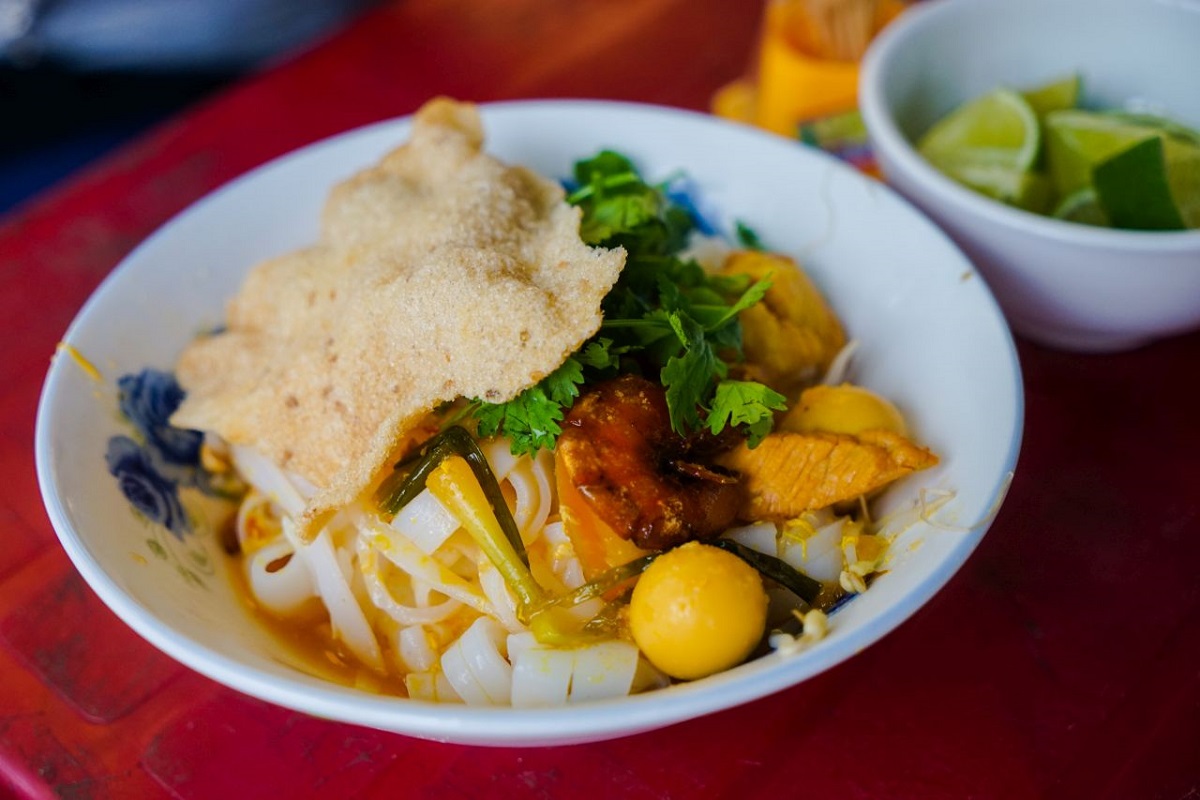
Bánh Mì
Banh Mi (“bang me”) is known as “Vietnamese sandwich” and one of the most famous Vietnamese foods in the world. This delicious bread is the second dish added in the Oxford dictionary. It’s simply a baguette filled with different meats, pate, pickles, raw vegetables, herbs and sauces. Each region in the country has its own combination. In Noi An, the bread is made with both rice and wheat flavours, therefore it’s crunchy all day long without baking again. In many sellers, travelers will have at least 4 choices of meats to choose from and enjoy. That are egg, char siu pork, sausage and Vietnamese sausage (chả lụa). In reputable restaurants, such as Banh Mi Phuong, the ingredients are more abundant. Price of a banh mi in local places ranges from 15,000 to 25,000 VND, while tourist ones charge more expensive.
Read more details and see the best places in The Best Banh Mi in Hoi An

Bánh Bao Bánh Vạc
Banh Bao (steamed bun) and Banh Vac (white rose dumplings) are a couple of specialty foods served in the White Rose Restaurant in Hoi An. The first is made by rice powder and a fully-flavoured filling that is a mix of pork, wood ear and spring onion marinated and stir fried. The dumplings have the same ingredients and steps to make, but their shape is different. Due to its rose-like appearance, tourists called it “white rose dumplings”. In the restaurant, travelers still see the makers at work around a large tray with the dough and pot of fillings nearby. This is the only place (family) where the dumplings are made.
Cơm Gà
Com Ga is chicken rice, pronounced “kom gah” in Vietnamese. It’s one of most loved local specialty foods in Hoi An. This tasty dish comprises yellow steamed rice topped with shredded chicken salad, peppermint, sliced white onion, plated green papaya and pepper. It is served with a small bowl containing a bold broth with chicken blood cubes and organs. To eat, locals use chopsticks and spoons to mix everything together. Someone may add chilli sauce, lime and sauces to enhance the taste. A com ga costs 20,000 to 30,000 VND commonly, but it’s higher in touristy places.
Read more details and the best places to eat in The Best Chicken Rice in Hoi An
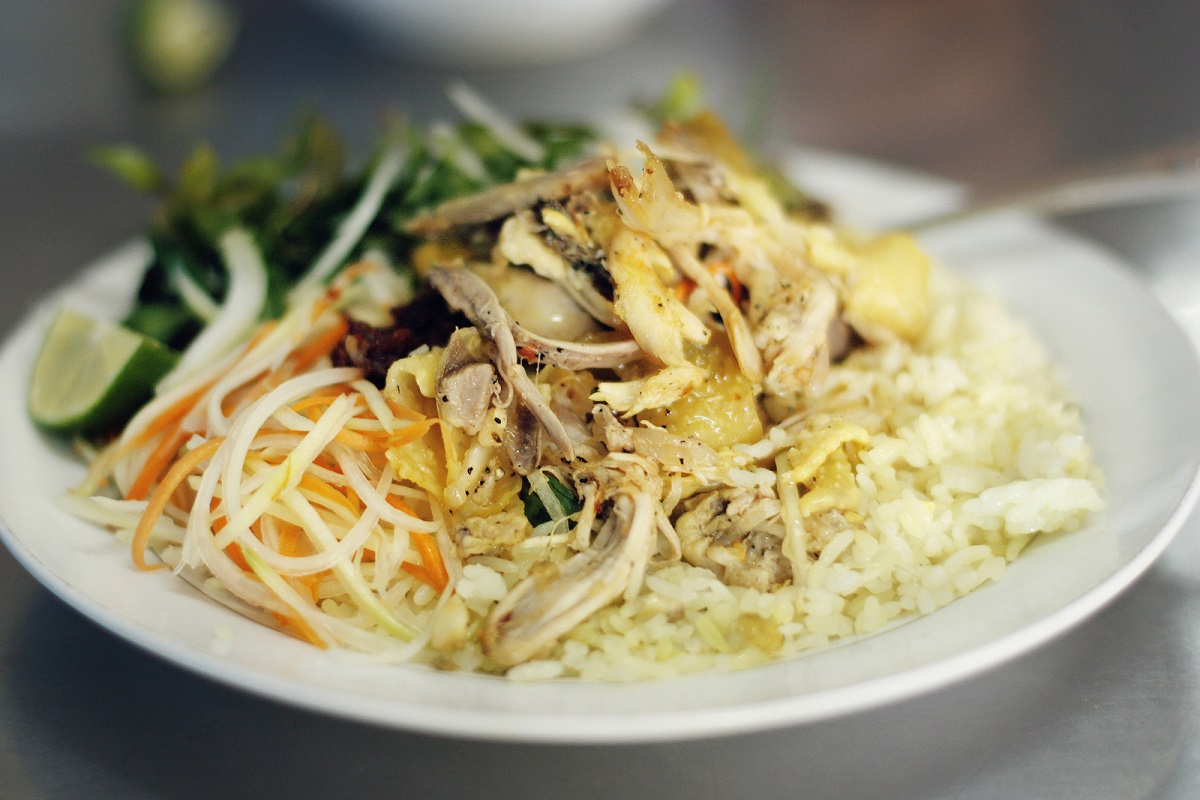
Phở Hội An
Pho (“fuh”) is Vietnam’s national food, a noodle soup originated from the north delta. However, Vietnamese living in Hoi An created their own style of Pho that has some differences from the primary recipe. Basic things are still preserved, such as use of broth from slowly cooked bones and spices, and beef as main meat. Local noodles are chewy, because the makers prefer dry noodles to fresh ones. Vegetables served are pickled sliced green and mature papaya, blanching bean sprouts and herbs from Tra Que village. To add more flavours, the diners can add local-style chilli sauce, fish sauce, lime or pickled onion and carrot. Pho is sold and eaten in every meal during the day.
Read more details and the best places to eat in The Best Pho in Hoi An
Bánh Uớt Cuốn Thịt Nướng
Name of this specialty food is longer than others because it’s combined by two main ingredients to make it, Banh Uot – fresh rice papers and Thit Nuong – grilled pork skewers. In addition to these mains, travelers also are served raw vegetables, sliced cucumber and green mango, and a bowl of scrumptious peanut sauce. Locals will use the rice paper to roll the barbecue, vegetables and slices together, and then dip into the sauce to enjoy. The taste is addictive for many people, a mix of many tastes. The most different thing compared to other similar dishes in the country, is about its skewers. The makers split a bamboo chopstick into 2 (but not all) and grip the piece of well-marinated pork. Finally, they tie by a string of banana leaves that are so easy to open.
The Night Market and Central Market
Around the sunset and evening, travelers definitely see many open charcoal grills where the vendors cook pork skewers across the town. The Night Market and Central Market have the largest concentration. A skewer is sold with a price of 10,000 VND but the sellers feel happy if at least 5 are bought because they serve vegetables and sauce as compliments. On the pavement or in parks, the diners sit on a low plastic chair, roll and enjoy people watching.
Quan Anh
This is a local eatery near An Hoi Bridge, at 132 Nguyen Thai Hoc St. Opened from 4 p.m to sold out, it serves a set of 10 grilled pork skewers with a price of 100,000 VND. Moreover, the diners also can find other food specialties like cao lau, mi quang, nem lui (lemongrass pork skewers) or sweet soup. While eating here, it’s possible to look at bustling crowds and lightful scenes of lanterns.
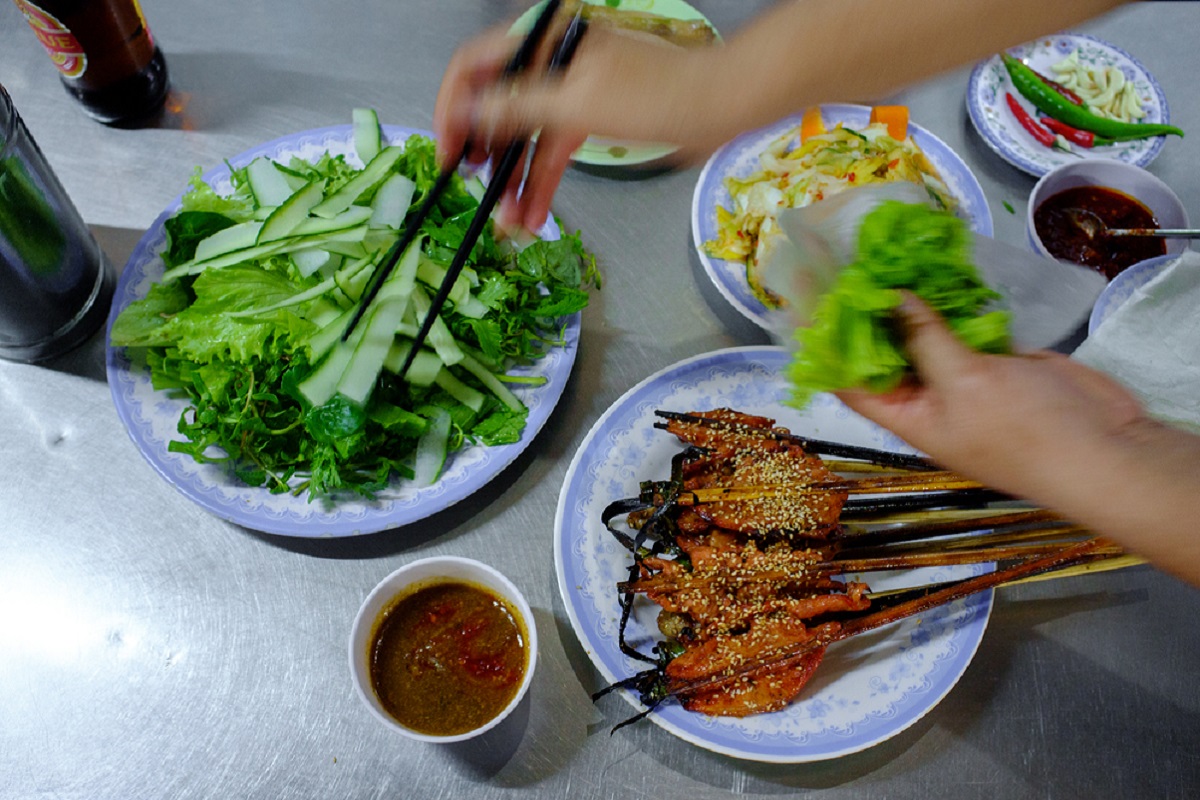
Hoành Thánh Chiên
Hoành thánh chiên is fried wonton in Vietnamese language, introduced by Chinese into Hoi An from 15th century. Around the town, it’s sold in a separate dish or in a combo with other local specialty foods. To make this perfect appetizer, the makers deep fry pieces of wheat dough into hot oil, then top them by stir fried meats with vegetables and garnish with herbs.
Miss Ly Cafe
In Nguyen Hue St, fried wonton here is mentioned a lot by travelers who ever visited and tasted it. A set of 4 pieces with meat as pork and shrimp, costs 110,000 VND. In the rest of the menu, there are various delicious eats to give a try.
Hi Restaurant
Located on the waterfront of An Hoi island (opposite to old town), this local-style restaurant serves 4 pieces of fried wonton each dish. Diners can choose pork or shrimp to serve with the tomato sauce. Here, vegan cooking class is also given so much love.
Bánh Xèo
Banh Xeo (“banh xiao”) is one of most popular dishes throughout the Central and South of Vietnam. Its main ingredient is the rice milk that is a mix between rice flavour, water and turmeric powder to create an eye popping yellow color. The makers will pour this milk into a hot skillet over burning charcoal and add meats or seafoods and bean sprouts later. This step makes a sizzling sound that gives the name to the dish. When the cake becomes crispy, they fold it into two and then may cut the piece in half to allow the diners easier to eat. In Hoi An, people use rice paper to wrap Banh Xeo with pickles, sliced cucumber and mango, raw vegetables and herbs. For more flavours, they dip the roll into a peanut sauce or nước chấm (fish sauce mixed with lime, sugar and chilli).
Bale Well Restaurant
This is the most famous banh xeo restaurant in town, located in a lane of Phan Chu Trinh St. Its name is taken from an ancient freshwater well nearby, Ba Le well. Patrons and tourists often get a combo of pancakes here that also include fried prawn spring rolls, lemongrass pork skewers, dipping sauces and vegetables to wrap. It’s perfect for dinner. The price is 120,000 VND.
Bánh Bèo
Known as “water fern cakes”, this Hoi An food specialty is a rice cake served with sweet, spicy fish sauce and eaten by a spoon. It’s made with rice milk, sometimes mixed with tapioca powders to create a chewy taste. The makers pour the milk into small ceramic bowls and then steamed. To serve the diners, they add prawn and peanut sauce and top it with fried shallots and noodles. Due to be arranged around a tray, this dish looks so “photogenic” that it is on the radar of many instagrammers. It’s sold in both street vendors and restaurants.
Banh Beo Ba Bay
This pavement vendor stall sells a set of 10 banh beo (bowls) with a price of 35,000 VND. Moreover, the owner also makes tasty bánh bột lọc or clear dumplings and bánh nậm or flat and tender rice dumplings. Her location is in Hoang Van Thu St, near the Chinese all-community assembly hall.
Bánh Đập
This simple dish is two rice crackers gripping fresh rice papers in the middle, and served with anchovy sauce. Its name originates from the action that the makers do when prepare, beating the cake. Foodies can find to eat in local eateries in the end of Nguyen Tri Phuong St, in Cam Nam island. In the same place, hến xào (baby clams) is also seen on the menu.
Hến Xào
This dish is baby clams stir fried with white onion, pepper mint and spices. Locals break a piece from rice crackers to spoon it and enjoy then. The clams are collected from Thu Bon river and boiled by people living in Cam Nam island, near the Central Market. There are some good restaurants at the end of Nguyen Tri Phuong St and by a body of water. The price is cheap. Furthermore, diners will see cao lau noodle, banh dap “beaten cake” or sweet corn soup on the menu.
Bánh Ít
Banh It is widely translated into “little cake” due to its small size, pronounced “bang it”. This yummy glutinous rice bun is pyramid-shaped, filled by green bean or coconut meat and popularly wrapped by banana leaves. Its taste is sweet or unsweet to different sellers and occasions in the year. In the Cham islands, heart-shaped ramie leaves are used to create a black color for the buns. That is called “banh it la gai”, sold around the main island. In the set menu lunch in guided day tours there, it’s served as the dessert.
Related Posts
Bach Ma National Park: Hiking, Trekking in Da Nang and Hoi An
Two best places for trekking and hiking in and near Da Nang are Son Tra mountain (peninsula) and Bach Ma national park. Which one is better is actually personal because these
Hoi An Wet Season: What to Do in Hoi An When It Rains?
No beach, no pool, no outdoor adventures? What to do in Hoi An when it rains? This is a very popular question from travelers who come to Vietnam in the
Thanh Ha Terracotta Park
Between 15th and 19th centuries, Hoi An was one of major stopovers for sailing merchants to trade in Southeast Asia. Meanwhile, craftspeople in its Thanh Ha village produce high-quality pottery
Vinwonders Nam Hoi An Theme Park (formerly Vinpearl Nam Hoi An)
In addition to historical and cultural attractions, nowadays Hoi An also has a couple of amusement parks to entertain. Definitely, they’re ideal places for families with children and groups of
Am Phu Cave (Hell Cave) – Things to Do in Da Nang
Although in the Marble mountains – the most visited attraction in Da Nang, travelers often miss Am Phu cave. One of reasons is that it’s mentioned much online and not
Hoi An or Hue: Which is Better?
Both Hoi An and Hue cities are in the middle of Vietnam, and they’re not far from each other (about 130 km). Therefore, for those who travel from north to
The Official Hoi An Travel Guide (MUST READ)
By the estuary of Thu Bon river, Hoi An is one of the best places to visit in Vietnam. This Vietnamese town is a package for travelers – a pretty
The Hoi An Market (Hoi An Central Market) Complete Guide
The Hoi An Market is the first market in Hoi An ever. Over centuries, it’s still the largest market in town although the town has a much bigger size than
Hoi An Memories Show: The Best of Hoi An Impression Theme Park
The Hoi An Memories Show is a famous series of outdoor performances in Hoi An at the present time. Thanks to its exceptional production and great cultural stories, it becomes
Hoi An Bridge: Famous Bridges in Hoi An
Hoi An has many bridges because it’s located at the confluence of 3 rivers: Thu Bon river, De Vong river and Truong Giang “Long river”. The distributaries of these rivers
How to Get From Hoi An to My Son Sanctuary
My Son sanctuary is one of the most popular places to visit for tourists staying overnight in Hoi An, especially those who spend many days there. It’s known for a
Hoi An’s Chinese Assembly Halls and Chinese Temples
Chinese people migrated to Hoi An from the early 17th century. Today, Chinese communities as a whole are the second most important piece to form the town’s unique culture. The foremost
Hoi An Walking Tours: Heritage, Foods, Photography & Locals
Strolling around heritage quarters with a local guide is the activity that so many travelers love to do in Hoi An. It enriches their time in this lovely town. Firstly,
Hoi An Self Guided Walking Tour – Hoi An On Your Own
Hoi An old town is friendly for pedestrians, especially during the time that motorized vehicles (scooters, cars, etc) are prohibited to move around its heritage quarters. That is safe for
How to Visit Golden Bridge Vietnam
The Golden Hand Bridge of Ba Na hills today is a dream place to visit for many travelers. Since it opened in June 2018, millions of people have set their
Unique Experiences in Hoi An and Why?
Today, travelers seek more experiences in the destination they go to. They want to have a deeper understanding about the culture of local people and interact with them. No other
An Bang Beach: A Guide to Hoi An’s Best Beach
An Bang beach now becomes a popular tourist attraction in Hoi An. It may be the best known and most convenient to reach from the town’s centre. Not only tourists,
Experiences in Hoi An: Get Insight Into Hoi An’s Local Culture
As the most unique Vietnamese town, Hoi An is definitely worth visiting. Here, visitors have many things to do and experiences for their holiday time. Everyone knows that it has
Things to Do in Ba Na Hills Besides Golden Bridge
According to local authorities, 50% of visitors coming to Da Nang and Hoi An visit the Ba Na hills. In other words, that is nearly 10 millions of people. This
Hoi An Nightlife: What to Do in Hoi An At Night?
After dark, Hoi An becomes exceptionally spectacular. If planning to stay overnight or visiting this ancient heritage town, at least travelers know that it’s “decorated” by so many colorful lanterns.
Hoi An Countryside: Villages, Rice Fields & Tours
By the coast, Hoi An is at the confluence of 3 rivers: Thu Bon river, Truong Giang river and De Vong river. This economically strategic location has supported trading activities
How to Get to Golden Bridge From Hoi An
There are many travelers visiting the Golden bridge from Hoi An. Both the bridge and the town today are must-see places in the region, so staying overnight in the town
Hoi An Entrance Fee: Old Town, Golden Bridge, My Son, More
Are you planning to visit Hoi An? And you don’t know how much cash you need to prepare for visiting places? This article lists tourist attractions in Hoi An and
Hoi An Airport: Everything You Need to Know
Hoi An is a famous tourist city in Vietnam. It’s 800 kilometers away from Hanoi, the capital of Vietnam and nearly 1,000 kilometers from Ho Chi Minh city, the biggest
Hoi An Lantern Boat Ride on Hoai River
A lantern boat ride is a thing to do that visitors must do today in Hoi An. For many centuries, locals have taken it on the Hoai river by the
Hoi An Private Car and Driver
Hoi An is one of the most popular tourist destinations in Vietnam. In the busiest year, it attracts about 9 millions visitors who come to enjoy its charming beauty, rich
What to Do in Hoi An Ancient Town
Hoi An Ancient Town is a must see, not only thanks to its world heritage title, but also to its vintage urban landscape, lots of attractions and activities. In the
Da Nang and Hoi An Itinerary for Visitors Staying Overnight in Hoi An
Da Nang and Hoi An are twin cities in the heart of Central Vietnam. Both are popular tourist destinations for either domestic or international visitors, and share many similarities. Due
Hoi An 3 Day Itinerary: A Travel Plan for 3 Days in Hoi An
3 days are a perfect duration to stay overnight in Hoi An and explore captivating places in and around it. Especially for those who travel from city to city or
Hoi An Free Things to Do: Budget Travel in Hoi An Vietnam
Travelers should know free things to do in Hoi An, to save the budget for this wonderful city and by that, can stay longer to explore. From old town, countryside
Hoi An One Day Itinerary: A Travel Plan for One Day in Hoi An
From a backwater town in the 1990s, Hoi An today is one of leading tourist destinations across Vietnam. In a recent year, it attracted 8,5 millions of overnight visitors and
Hoi An Half-Day Tours: Guide to Half Day Trips From Hoi An
Top attractions near Hoi An require a couple of hours or half a day, to get there and visit around. The reason is that all have many things to see,
Hoi An Day Tours: A Guide to Best Day Trips From Hoi An
Near Hoi An, there are many fantastic places making travelers can’t stay in the room and have to go out to explore. Appeal Golden bridge – the new world wonder,
Hoi An Beach: A Guide to All Beaches in Hoi An Vietnam
Not only an old town, Hoi An has beaches as well! That are sandy, edged by tropical water and lined by palm forests. Travelers don’t need to wait or move
Hoi An Food Specialties
Hoi An is a melting pot where people from different parts of Vietnam and countries in the world have gathered and exchanged their cultures. As a result, this town has
How to Get From Hoi An to Da Nang
Da Nang is the neighbouring city of Hoi An. It's the capital of Central Vietnam and has the most important (busiest) transport hubs of the region, such as airport, train
Hoi An Cheap Things to Do: All Solo Travelers Need to Know
Knowing free and cheap things to do in the city where travelers are going to visit, is helpful. First of all, they can save and, thanks to that, can stretch
Hoi An Best Things To Do: Recommendations from Local Experts
It is no coincidence that Hoi An is in the list of must-visit places once in the lifetime of many travelers. Located by a river, it’s borned to welcome people
Hoi An Things to Do: All What Can You Do in Hoi An Vietnam
Hoi An is in the bucket list of most travellers who plan to visit the Central part of Vietnam. It’s a lovely old and small town located downstream of a
Hoi An Things Not to Miss: A Guide to Must Do in Hoi An
In fact, there are so many things to do in Hoi An, one of the 10 best cities in Asia by Travel + Leisure in 2021. It has a lantern-filled
Hoi An or Da Nang: Which is Better for First Time Visitor?
Da Nang and Hoi An are located in Central Vietnam, with a distance of roughly 30 km. To the north, Da Nang is the capital city of the region, with
Hoi An Pottery Village: A Guide to Thanh Ha Pottery Village
Hoi An used to be a bustling, prosperous trade port during past centuries, before its role was replaced by Da Nang. Merchants from many countries on different continents came here
Hoi An Ancient Town Tour
Hoi An Ancient Town is a Unesco world heritage site by the mouth of the Thu Bon River. It has grid-plan streets filled by silk lanterns and bougainvillea flowers that
Hoi An Old Town Ticket: Price, Sellers, Included Sites, More
As an attraction including attractions, Hoi An Old Town requires an entrance ticket to tourists who come from other parts of Vietnam and the world. It raises funds for preservation of
My Son Sanctuary Tour
My Son Sanctuary is a Unesco world heritage site, attracting 450,000 visitors in recent years. It’s the best remains left by the fallen Champa Kingdom which ruled a part of
Hoi An Lanterns: Festival, Making Class, Where to Buy, More
Lanterns are the signature of Hoi An Old Town, the 3rd Unesco world heritage site in Vietnam. Especially at night, these traditional handicraft objects are lit up and make the town
Hoi An Best Area to Stay: Guide to Where to Stay in Hoi An
In the busiest year, nearly 5,5 millions travellers decided to stay overnight in Hoi An. It’s the largest number that a city in the Central coast of Vietnam ever achieved.
Hoi An Weather by Month: Guide to Hoi An Monthly Weather
Hoi An won the title “Asia’s leading cultural destination” recently in a reputable global travel award. It’s a pretty riverine-coastal town with an ancient root, surrounded by peaceful pieces of
Hoi An River Cruise: Guide to The Best Boat Tour in Hoi An
Hoi An town is by the left bank of the Thu Bon River, and by that, it draws plenty of merchants by sailing boat to visit and trade. Its golden
Hoi An Old Town Boats: Guide to Boat Rides in Hoi An Town
Hoi An town sits by the left bank of the Thu Bon River, the largest and most important waterway in mother Quang Nam province. It’s also near the mouth of
Hoi An 2 Day Itinerary: Traveler Guide to 2 Days in Hoi An
2 days are enough to know the highlights in Hoi An, a famous tourist destination in Central Vietnam. And for those who travel from city to city, 48 hours are
Cham Island Hoi An
The purple islands seen from An Bang or Cua Dai beaches are the Cham Islands. It’s one of the kind in the region where God bless it with fabulous beautiful
Hoi An Basket Boat Ride
Nowhere else outside of Hoi An Coconut Village, travelers can find a basket boat ride across the immense palm forests. It’s an experience that allows the passengers to know better
Hoi An Coconut Village: A Guide to Cam Thanh Coconut Village
Hoi An Coconut Village boasts of the most interlaced waterway system in the city. Four rivers encircle it and are connected together with smaller canals. Thanks to fertile alluvia and
Hoi An Cham Temples: My Son Sanctuary & Quang Nam Temples
Cham people settled in Hoi An before the Vietnamese arrived and handed it over in 14th century. Influenced by Indian culture, they called the land “Amaravati”, similar name to a
How to Get from Da Nang Airport to Hoi An
Located in the city of the same name, Da Nang airport is the nearest airport to Hoi An. So, if travelers want to see an extremely-colorful Lantern festival or try
Da Nang to Hoi An: Best Da Nang Airport Transfer and More
If traveling to Hoi An by air, train and cruise ship, visitors will come to Da Nang first and then have a transfer. The largest city of Central Vietnam holds
Hoi An Tour Guide: How to Find a Private Tour Guide in Hoi An
Most tour packages in Hoi An cover “ a guide”. He or she may be the first and closest local to the visitors, who lead the group to enjoy the
Hoi An Ancient Town Attractions
Spreading over an area of 30 hectares, Hoi An Old Town owns more than 1,100 timber buildings varying in function or type. In the oldest street, the Japanese bridge spans
Hoi An Old Town Map
There are so many things to see, do, eat and sleep in Hoi An Old Town, so the visitors often are confused while planning and exploring. Starting the research from
Tra Que Vegetable Village
Located in a prime location between two famous attractions, the Old Town and An Bang beach, Tra Que vegetable village is a featured point of interest. It’s famous for vegetable
Guide to Hoi An Lantern Festival – Hoi An Full Moon Festival
The Lantern Festival is amongst the best times to visit Hoi An. In which, visitors will immerse themselves in a shimmering world of uncounted lantern lights. When the crowds fill
Hoi An Night Market: A Thing to Do in Hoi An at Night
One of the most visited attractions in Hoi An is its night market. Because it is located right near the Old town, first-timer travelers commonly explore both top sights in
My Son Sanctuary Travel Guide
My Son Sanctuary is a complex of Hindu temples and a Unesco world heritage site from 1999. It’s 40 km away from Hoi An and 70 km to the southwest
Hoi An Old Town Unesco World Heritage – Hoi An Travel Guide
Situated 30km south of Da Nang, Hoi An ancient town is one of the best attractions in Central Vietnam. It is titled as the prettiest town of the country and
